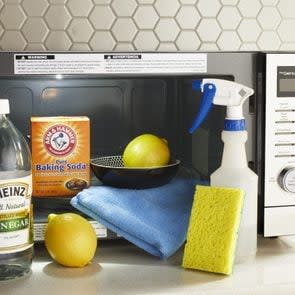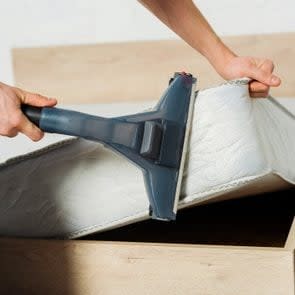How to Clean Quartz, Granite, Marble, and Butcher Block Countertops
Maintenance doesn’t have to mean high maintenance, especially when it comes to keeping quartz, granite, and marble countertops clean. Even though these materials look gorgeous and refined—and, yes, high maintenance—they’re actually pretty easy to maintain if you know what you’re doing. Clueless about how to clean countertops? That’s where our step-by-step guide comes in.
Countertops are some of the most used surfaces in our homes. We cook on them, eat on them, and even do our work (or homework) on them. That’s why they should be among the things most frequently cleaned in the kitchen.
There’s a catch, though. Because countertops are multiuse surfaces and some materials do not play nicely with certain ingredients in cleaning products, you need to know exactly how to scrub and sanitize without compromising or damaging the elegant finish. And you certainly can’t follow the same guidance as you would when cleaning a dishwasher or stainless steel appliances. So set a regular cleaning schedule for yourself, then follow our handy guide. You’ll know how to clean countertops in no time.
How to clean quartz countertops
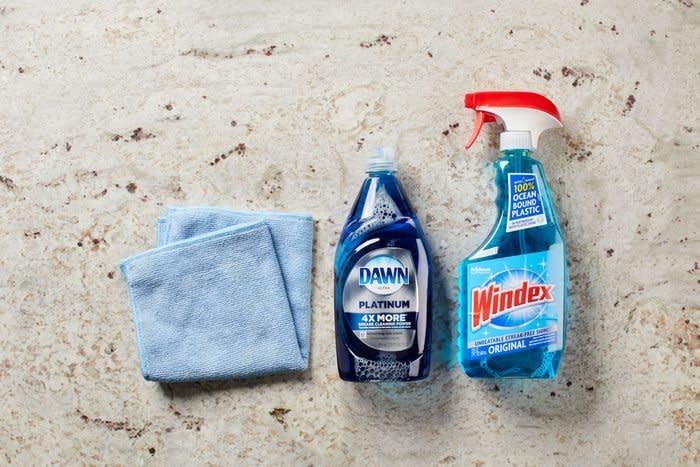
Quartz countertops are sourced from all over the world and are available in just about every pattern and color you can think of. Not only are they elegant, but they’re also incredibly durable—even without a sealing process. They resist stains, mold, mildew, and bad-smelling bacteria, thanks to their nonporous surface, so your kids (or you!) can make a total mess without worrying about its impact. In short, they’re a coveted item for anyone who dreams of utility and beauty.
Caring for quartz
These countertops may be durable, but that doesn’t mean you can avoid proper care. As a general rule of thumb, don’t let spills linger. The longer they sit on the quartz, the more time the liquid has to dry and the harder it becomes to remove it.
The best way to keep your countertops looking brand new is to prevent damage in the first place. “Using a cutting board on quartz is an effective way to protect the countertop and minimize stains and mess,” says John Otero, regional director of PuroClean. “Kitchen mats are also great to protect your quartz countertops from heat damage, corrosion, and scratches to the surface.”
The tools you use to clean your counters matter, so stick with these expert-approved picks:
To wipe off a just-spilled liquid: Simple dish soap and a soft cloth, whether a rag or a microfiber towel, work just fine.
To get rid of hardened, tougher stains: Wipe the counter with a glass or surface cleaner, using a cloth or soft, nonabrasive sponge and a little elbow grease.
Quartz is durable, but there’s a limit to everything. Steer clear of the cleaning products below, which can harm your counters.
Ditch rough sponges. Be sure that your sponges are soft all the way around, without the rough scouring pad, which can wear down the quartz’s brilliant shine. As Otero reminds us, quartz “may be scratch resistant, but it’s not always scratch proof,” so do your best to limit contact with corrosive materials.
Skip aggressive cleaning solutions. Clorox, oven cleaners, concentrated bleach, nail polish remover, and similar harsh chemicals can dull the surface. “Avoid anything that is either too acidic or too basic,” says Otero. “The acids in vinegar will dull the quartz, and the alkaline in ammonia and bleach can cause discoloration.”
How to clean quartz
Ideally, countertops should be cleaned daily with dish soap, water, and a rag to avoid a buildup of grease and grime. Dish soap cuts through grease, but if your counter still has a slick look, try a degreasing product, such as Krud Kutter or Easy-Off, to break it down.
For a weekly deep clean or to remove a stubborn spot, level up to a glass cleaner and sponge. Here’s how to do it:
Generously spritz the countertop with glass cleaner.
Let it sit for 10 minutes.
Wipe the counter clean with a sponge. Keep in mind: Hardened stains may take a minute or two to loosen.
Preventive counter care
A quick, daily wipe-down will extend the life span of your quartz countertops. You’ll be amazed at what simple daily maintenance can do for your countertops while also reducing your cleaning time later. After all, if food particles don’t have a chance to build up, you won’t need to scrub at them later.
Tips and tricks for quartz counters
Quartz is a shiny, glossy rock and can withstand a lot of activity and liquids, but you definitely shouldn’t expose quartz countertops to abrasive cleaning products. Instead, boost the shine with glass-cleaning products and gentle sponges. It’s also a good idea to use trivets as a barrier to high heat, which can cause the quartz to crack.
With that done, it’s time for another cleaning project. Ready to tackle organizing the fridge?
How to clean granite countertops
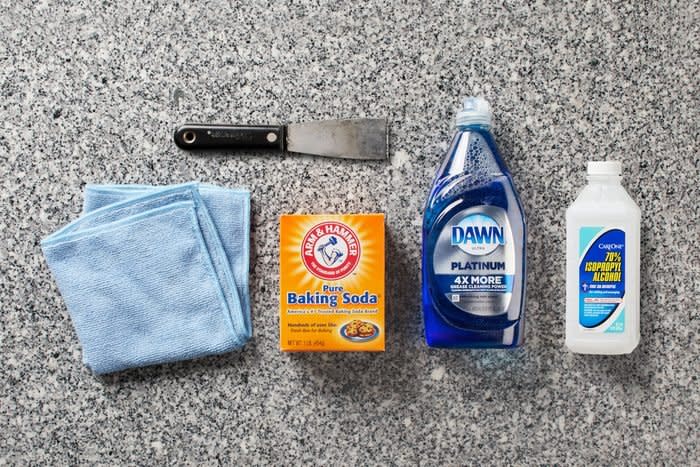
Pretty, glossy, and stain resistant, this natural stone remains the go-to countertop for home buyers and remodelers. While both granite and quartz up a home’s elegance, there’s a big difference between the two: Granite is porous, and quartz is not.
Caring for granite
The most crucial nugget of information to know about granite countertops is that they are a porous material, so they absorb liquids. Luckily, there’s an easy work-around: an annual sealant, like this one from TriNova. If properly sealed every year, granite will withstand even the messiest of messes.
Keeping the sealant intact throughout the year is key to the health of the granite. So be sure you’re using the proper tools. You don’t need anything fancy; a sponge and some soap will do.
Also crucial: avoiding bad-for-granite ingredients. Protect the sealant by avoiding acidic cleaning products like vinegar, Windex, and bleach. They’ll weaken the seal and dull the finish, which Otero says will “ruin the smooth, shiny surface that makes these kinds of countertops popular options that increase home value.”
Another thing to avoid at all costs is a scratchy scouring pad. “Opt for a kitchen cloth instead of hard-scrubbing brushes,” he says.
How to clean granite
Cleaning granite countertops couldn’t be simpler. For everyday crumbs and spills, follow the steps below.
Use a soft, dry sponge to dust off any crumbs or larger debris.
Add a little soap and water to a soft sponge.
Start cleaning at the back of the countertop, working your way to the front in a broad side-to-side motion (similar to a windshield wiper). You may need to scrub away caked-on messes, but avoid using the rough side of the sponge—it could damage the granite.
Typically, simple soap and water will do the trick, but hardened stains may require a bit more oomph. There are a few useful ways to scrape off crusted-on messes:
Use a razor. For the bravest among us, a razor blade can be used to carefully scrape away the buildup. You can also use a putty knife for a slightly gentler option.
Use a plastic knife. If you’re worried about damaging your counters, grab a plastic knife to loosen the gunk.
Use baking soda. Create a paste from baking soda and water, and apply it to the stuck-on mess. Place plastic wrap over the paste and let it sit on the offending spot for a day (or however long it takes to dry). It’ll loosen the stain and make it easier to wipe away.
Whichever method you choose, finish the job by rinsing away the residue with a soapy sponge or cloth. And make sure you wipe away the suds thoroughly—any lingering liquid can break down your countertop’s sealant over time.
How to disinfect granite
Cleaning your countertops is one thing. It’ll get rid of food spills, crumbs, and other messes. But it won’t necessarily disinfect your space. For daily disinfecting, Otero recommends making your own solution that will clean and protect.
Fill a spray bottle with a 50-50 mix of water and isopropyl alcohol.
Spray the entire counter.
Let the spray sit for five minutes.
Wipe the counter dry.
Bonus: Otero’s simple recipe also “limits the possibility of damage that can come with the constant use of harsh cleaners,” he says. Easy peasy, right? The time-saving steps above will clear up your cleaning schedule for deeper cleans, like scrubbing your oven until it shines.
Preventive counter care
Everyday wear and tear accumulates over time if steps aren’t taken to prevent and protect, so being consistent with the daily care outlined above will ensure your granite countertops glisten for years to come.
Tips and tricks for granite counters
Keep an eye on the granite sealant. If it appears to be wearing faster or if you have young children and spills are a regular thing, don’t wait to have your countertop resealed. And if you keep your countertops spotless, you may be able to stretch the seal for up to two years.
To revive dull-looking countertops, pour a tiny bit of olive oil onto a cloth and wipe it over the granite to instantly reveal a megawatt shine.
How to clean marble countertops
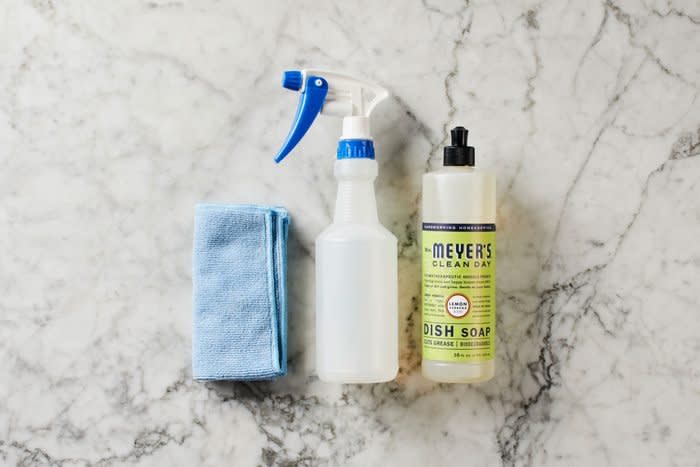
Beautifully marbled countertops cost a pretty penny, but they also ooze glamour and luxury. Thankfully, they couldn’t be easier to clean. But fair warning: Keeping this sensitive material in all of its brand-new glory can be a nightmare if you aren’t careful. A laissez-faire attitude can leave your countertops exposed to acids that will do damage. Protect your investment by following proper cleaning protocols, babying your counters the way you baby your television when you clean your TV screen.
Caring for marble
Marble is renowned for its stunning appearance, but it’s also super sensitive to acidic liquids, like lemon juice and vinegar. Even just a splash of lemonade, if not immediately cared for, can eat away at the otherwise durable material, leaving blemishes in its wake. “The key to maintaining any kind of countertop is to remain active in the cleaning process after food preparation,” says Otero. “Clean as you go, and don’t let spills accumulate.”
Equipping yourself with the right cleaning tools is essential to maintaining the marble’s unique character. And surprisingly, these simple ingredients win:
Dish soap
Water
Soft cloth
Optional: specially formulated marble cleaner
The trick to keeping marble sparkling is to avoid letting it come into contact with an acidic liquid, whether it’s an incorrect cleaning product (think harsh cleansers like Lysol) or simple marinara sauce. Definitely strive to keep staining liquids, like fruit juices, coffee, wine, and tomato sauce, far away from countertops. If you don’t, the marble will appear dull or develop etchings, which are large swaths of dull spots.
How to clean marble
This is one instance in which being basic is a good thing. Keep the cleaning process for marble super simple and just use soap and water for everyday care. “When in doubt, stick to a simple dish soap and warm-water spray,” says Otero, adding that you can pour a little bit of rubbing alcohol into the mix for added disinfecting power.
How to clean run-of-the-mill messes:
Mix gentle dish soap with water in a spray bottle.
Spritz the solution onto your countertops.
Use a soft, nonabrasive kitchen sponge to wipe down the surface or lightly scrub a dirty spot, if necessary.
If a dirty area resists your first attempt, repeat the process until the particles loosen, but do not double down on the scrubbing—it’ll only make your marble more vulnerable to damage.
Oil-based stains are the most common offenders and typically result in a dark spot on the marble. Thankfully, there’s a work-around.
How to lighten or neutralize dark stains:
Mix dish soap with a splash of bleach or acetone.
Spritz directly onto the spot.
Wipe away the spray immediately.
Finish with a rinse of soap and water to remove the remaining residue.
Marble is a sensitive stone, so coffee, tea, wine, fruit, and most other food items have the potential to leave behind unwanted stains if left on the surface for too long. Thankfully, you can do something about them.
How to remove food-related stains from countertops:
Dilute 12 percent hydrogen peroxide with water.
Lightly scrub the stain with a clean cloth.
After the spot disappears, wipe the spot with a new, damp towel to fully remove the chemicals.
Pat dry.
While all stains or splashes should be addressed immediately to prevent long-lasting damage, if you find one that has hardened or settled in, you may need to take more aggressive measures to remove it. This is where marble care products can be helpful, but the above DIY remedies are solid options too.
No matter which cleaning method you use, once the dirty bits are gone, dry off your countertop with your rag to ensure no soapy bubbles are left behind. To dial up the shine, buff the top with a soft, absorbent towel until it sparkles.
Preventive counter care
It’s not enough to know how to clean countertops. For marble, in particular, you need to know how to keep them clean to avoid the work that comes with turning a stained, dulled counter into a shining surface once again. If you have marble counters, prevention starts with avoiding acids on your countertop. Mop up liquid spills, don’t cut that lemon on the counter, and trade harsh cleaners for soap and water.
Tips and tricks for marble counters
If your marble countertop just doesn’t shine the way it used to, you may need to re-sand it to remove scratches, etches, and other imperfections. After that, it’ll need to be repolished to perfection. Leave this to the professionals, though. Otherwise, you’re just asking for trouble.
How to clean butcher block countertops
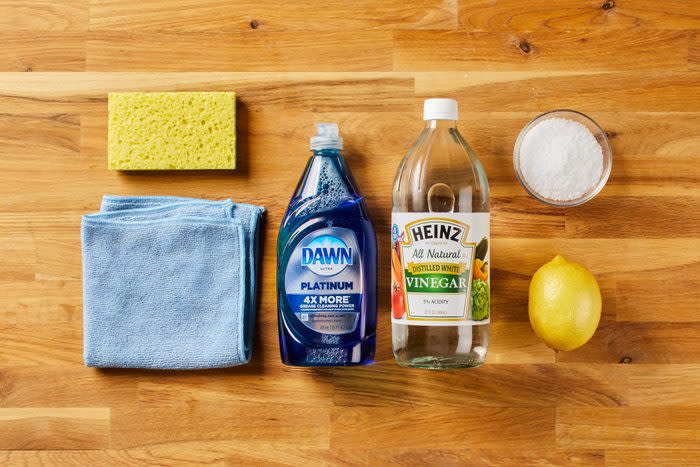
Butcher blocks are becoming increasingly popular in kitchen designs, often used as an additional countertop surface near the stove or atop a kitchen island. They’re inexpensive and multiuse: You can cut vegetables or other types of food right on top or leave them in perfect condition as a countertop.
There’s a catch, though: If the block becomes scratched, bacteria can grow in the crevices, making it less than ideal for prepping poultry or meat. “Butcher blocks are porous, so the key difference to remember is that they are more prone to stains and damage from liquids compared to stone countertops,” says Otero, noting that their softer surface makes them more susceptible to dents. “What’s important to know is that natural wood products require some specialized care to keep them clean, sanitized, and well-maintained.”
Caring for butcher block
Similar to granite and marble, butcher block must be sealed with a food-safe oil or finish. And it’s important to know your butcher block’s type: edge grain, end grain, or face grain, for instance. Additionally, if the seal looks worn down, it’s time to have it resealed or replaced altogether.
The good news is that wood can handle a stronger touch, so scrubbing with a sponge that has a scouring side is A-OK. Make your own stain solution with products you probably already have at home, including dish soap, white vinegar—a do-it-all product that’ll also clean your shower head and coffee maker—salt, and lemon juice.
As with other countertop types, there are downsides to consider. If you’re thinking of a butcher block counter versus a stone option, keep these points in mind:
Water is a no-no. Extended exposure to water is damaging. Never leave water standing on a butcher block counter, even if it’s in a sealed container, because wood quickly absorbs water. A spill, says Otero, can “cause it to swell, crack, or warp.” Not only will it compromise the integrity of the wood, but it could also trigger an unpleasant mold or mildew smell.
It could harbor bacteria. Whether you use your butcher block countertop as a cutting board is a personal preference. Scratches create a rustic, lived-in look, but they can provide a home for bacteria if they aren’t cleaned regularly and thoroughly.
They’re flammable. Just to state the obvious: Butcher blocks, although sturdy, are still wood and can blaze if hot pots, pans, or trays are placed directly on top. Be sure to use a trivet.
How to clean butcher block
Yes, you need to clean your counter daily. And yes, you also need to disinfect it—especially if you cut food directly on the butcher block instead of a cutting board. Here’s how:
Wipe or scrape off any caked-on sauces, food dribbles, or crumbs.
Drizzle a bit of dish soap onto a wet sponge and scrub along the grain of the wood.
Rinse the sponge and wipe down the butcher block with just water. Now it’s prepped for a stronger cleansing.
Pour a generous dose of white vinegar onto a clean dish towel.
Wipe the entire counter, leaving the vinegar on the block for 15 minutes to deeply disinfect.
Once the vinegar has dried, create a paste from one cup of lemon juice and a half cup of salt. Scrub the paste all over the counter, paying particular attention to scratches, stains, and spots.
Wipe the salt away with a clean dish towel or rag, and rinse the counter once again with a water-soaked sponge.
Soak up excess water, says Otero, and then pat dry with clean paper towels.
Preventive counter care
Maintaining a butcher block countertop is simple, and dish soap will do the trick. The catch: It needs to be done daily, especially if you’re pulling double duty and using your counter as a cutting board.
“For a deeper clean and to cut through grease, natural products like baking soda, salt, and lemon juice are all food-safe options,” explains Otero. “These ingredients are also good for removing lingering odors left behind from garlic, onions, or seafood and animal proteins.”
Tips and tricks for butcher block counters
Most butcher blocks are sealed with polyurethane, but if yours is not, it will need to be resealed often, regardless of whether it’s used daily or simply a decorative element. Blocks that are used regularly should be resealed with food-grade mineral oil once a month, while blocks that serve as decorative countertops only need to be oiled once or twice a year.
Once you’ve mastered how to clean countertops, it’s time for a new challenge. That’s right: It’s time to clean the bathroom.
Source:
John Otero, regional director of PuroClean
How to Clean Blinds and Drapes
How to Clean Your Microwave
How to Clean a Mattress
The post How to Clean Quartz, Granite, Marble, and Butcher Block Countertops appeared first on Reader's Digest.

